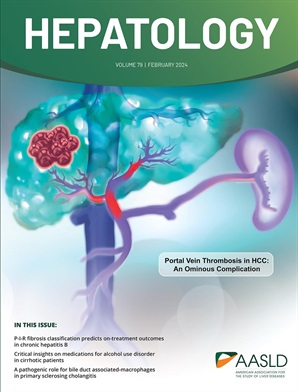Salivary microbiome and serum metabolomics add to clinical biomarkers to predict 6-month hospitalizations in a multi-center cirrhosis outpatient cohort
IF 12.9
1区 医学
Q1 GASTROENTEROLOGY & HEPATOLOGY
引用次数: 0
Abstract
Background & Aims: Prognosticating outcomes such as hospitalizations in cirrhosis outpatients is challenging, especially with changing etiologies and demographics. Aim: Determine impact of multi-omic strategies on outcome prediction. Approach & Results: NACSELD3 enrolls cirrhosis outpatients with controlled/eradicated etiologies from 10 centers and follows them systematically. At baseline, clinical/demographic and cirrhosis details were recorded and saliva and serum samples were collected for microbiome and metabolome analysis respectively. Multi-omic bioinformatic studies to determine interaction of microbiota and metabolites with clinical prediction of 6-month hospitalizations were performed. 565 patients (60.2 years, 68% men, 35% alcohol, 33% MASH, 21%, eradicated HCV with MELD3.0 12) were enrolled. 163 (29%) required 6-month hospitalizations; most (75%) were liver-related. Those hospitalized had worse cirrhosis severity, co-morbidity indices, but similar demographics and oral health variables. Salivary microbiome alpha-diversity was lower (1.96±0.48 vs. 2.09±0.45,唾液微生物组和血清代谢组学加入临床生物标志物预测6个月住院治疗的多中心肝硬化门诊队列
背景,目的:肝硬化门诊患者住院等预后结果具有挑战性,特别是在病因和人口统计学变化的情况下。目的:确定多组策略对预后预测的影响。的方法,结果:NACSELD3纳入了来自10个中心的病因控制/根除的肝硬化门诊患者,并对其进行了系统随访。基线时,记录临床/人口统计学和肝硬化细节,并分别收集唾液和血清样本进行微生物组和代谢组分析。进行了多组学生物信息学研究,以确定微生物群和代谢物与6个月住院治疗的临床预测之间的相互作用。565例患者(60.2岁,68%男性,35%酒精,33% MASH, 21%,根除HCV与MELD3.0 12)入组。163例(29%)需要住院治疗6个月;大多数(75%)与肝脏有关。住院患者的肝硬化严重程度和合并症指数较差,但人口统计学和口腔健康变量相似。唾液微生物组α -多样性较低(1.96±0.48比2.09±0.45,p=0.018),基线时病原菌较多(链球菌、密螺旋体、肠球菌科),共生菌较少(细络菌、普雷沃菌、嗜血杆菌、毛螺科)。血清代谢组学显示,住院/非住院患者在基线时存在显著差异,微生物来源(苯乳酸、次级胆汁酸、吲哚)、胆碱部分和多胺/GABA(3-尿酰丙酸/亚精胺)代谢物最为突出。临床、微生物和代谢组学变量使用随机森林的曲线下面积高于这些单独的变量。潜在因素分析显示,临床变量(MELD3.0、血红蛋白和白蛋白)对住院预测的影响最大,其次是唾液微生物群,然后是血清微生物群。结论:在一项病因控制的北美多中心肝硬化门诊队列研究中,血清代谢组学和唾液微生物组学作为临床变量可用于预测6个月的住院治疗。
本文章由计算机程序翻译,如有差异,请以英文原文为准。
求助全文
约1分钟内获得全文
求助全文
来源期刊

Hepatology
医学-胃肠肝病学
CiteScore
27.50
自引率
3.70%
发文量
609
审稿时长
1 months
期刊介绍:
HEPATOLOGY is recognized as the leading publication in the field of liver disease. It features original, peer-reviewed articles covering various aspects of liver structure, function, and disease. The journal's distinguished Editorial Board carefully selects the best articles each month, focusing on topics including immunology, chronic hepatitis, viral hepatitis, cirrhosis, genetic and metabolic liver diseases, liver cancer, and drug metabolism.
 求助内容:
求助内容: 应助结果提醒方式:
应助结果提醒方式:


